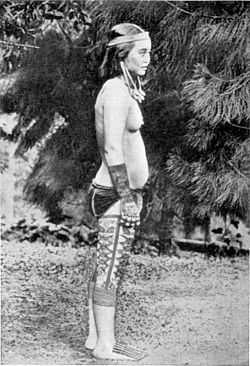Bornean traditional tattooing

Borneo Traditional Tattooing is a hand tapping style of tattooing with two sticks, developed by some of the ancient tribes of Borneo.[1]
Borneo tattooing designs
The most common of Borneo designs are thick black tribal work, which all have different meanings.
Nature is the main focus when designing a Borneo Traditional Tattooing such as leaves, animals, fruits, trees and branches.
Men's tattoos
The Bunga Terung, which translates to the eggplant flower, is the first tattoo a Borneo male would receive. The Bunga Terung is a coming of age tattoo which marks the passage of a boy into manhood. The Bunga Terung has a spiral at the center of the eggplant flower the Tali Nyawa, which means the rope of life and is identical to the underside of a tadpole which symbolizes the beginning of a new life.
All the tattoos, following the eggplant flower, are like a diary. A young male would go out on his own to find knowledge and from each place he went to he would get one tattoo to mark not only where he is from but also where he has been. From each place the tattoos have different styles so the regional differences in his tattoos would tell the story of his journeys in life.
Borneo tattoos do not just mark physical journeys. Some represent big life events, such as fathering children etc. For example there is a tattoo a man can have done on his hand called the Entegulun. You can only have this if you have taken heads. Some tattoos can be for protection, for example the tattoos on the throat (Ukir Rekong) are meant to give strength to the skin on the throat, to stop the bearer's enemies from being able to sever the bearer's head.
Borneo tattooing today
Many of the designs no longer exist. In the 1950s and 1960s many people in Borneo converted to Christianity and a lot of the traditional tattooing stopped. The tattooing and designs almost died away. About 10 years ago there was a resurgence when a lot of journalists and researchers came and asked questions about the old ways. This caused a lot of the younger people to look back and now many of them are getting these traditional tattoos done again.